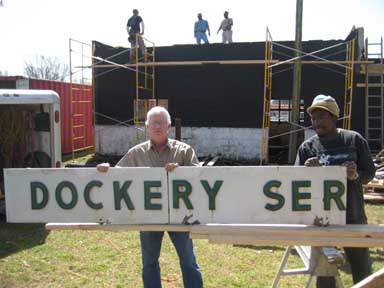
 |
|
William Lester, executive director of the Dockery Farms Foundation, and Prentis Hugles, of Cleveland Lumber Company, display the original Dockery Service Station sign that will be restored as part of The Dockery Service Station Restoration Project. |
The Dockery Farms Foundation is pleased to announce that it has been awarded a Save America’s Treasures Grant through the National Park Service of the United States Department of the Interior.
These funds will enable the Foundation to undertake the restoration of several buildings at the Dockery Farms Historic Site, beginning immediately with the Dockery Service Station. Hampton Tucker, Chief of the Historic Preservation Grants Division National Park Services states, “The National Park Service is pleased to participate in the preservation of Dockery Farms. This grant through the Save America’s Treasures program will allow all Americans to experience the birthplace of one of our great music traditions for years to come. Innovative public/private partnerships like this are the foundation of preservation of this country’s rich and diverse heritage.”
“We are delighted to have the National Park Service and Save America’s Treasures as our partners in preserving the buildings at Dockery,” said William Lester, Delta State University professor emeritus of art and executive director of the Dockery Farms Foundation. “This Save America’s Treasures grant and the matching support we have received from Bill and Carolyn Powers and others has enabled us to begin this urgently needed work.”
“Dockery is widely viewed as being ‘the birthplace of the blues’” said Dr. Luther Brown, Director of the Delta Center for Culture and Learning at Delta State University. “College classes from across the country and tourists from around the World want to visit this important landmark, and its preservation is vital to the development of heritage tourism as an economic engine for the Delta.”
Dockery Farms was established in 1895 by Will Dockery to cultivate cotton. By the mid 1920’s, the community at Dockery had grown to encompass several thousand people. At one time Dockery had its own infirmary, post office, commissary, rail road (the “Pea Vine”) and even its own currency. Dockery was home to a number of Blues pioneers, among them Henry Sloan, Charley Patton, Willie Brown, Tommy Johnson, and Roebuck “Pop” Staples. It was at Dockery that these musicians lived and learned from one another. They played in the boarding houses and on the commissary steps at Dockery. In turn they left Dockery and traveled to the North to record. Some of them later returned to Dockery. Their songs influenced the development of popular music all over the world. The extraordinary musical collaboration that happened at Dockery in the early 20th century has made the property a beacon for music fans and scholars from all over the world. The Dockery Farms Historic Site was added to the National Register of Historic Places with National Significance in 2006 and to the Mississippi Blues Trail in 2008.
The old service station was built in the 1940’s, long after Will Dockery’s death. Nonetheless, it will play an important role in the Foundation’s preservation and public education plans for Dockery Farms. The restored and converted service station will include a classroom for school field trips and other visitor programs, a small café, and the offices for the Dockery Farms Foundation. The Service Station Restoration Project, which is being conducted by Cleveland Lumber Company, is expected to be completed in four to six months.
The Dockery Farms Foundation is a 501(c)3 organization dedicated to preserving the historic property and heritage of Dockery Farms and developing these for educational purposes and the public interest.
For additional information, contact William Lester, executive director, The Dockery Farms Foundation at (662)719-1048 or blester@dockeryfarms.org.

